Q-Switched Operation with Carbon-Based Saturable Absorbers in a Nd:YLF Laser
Abstract
:1. Introduction
2. The Model
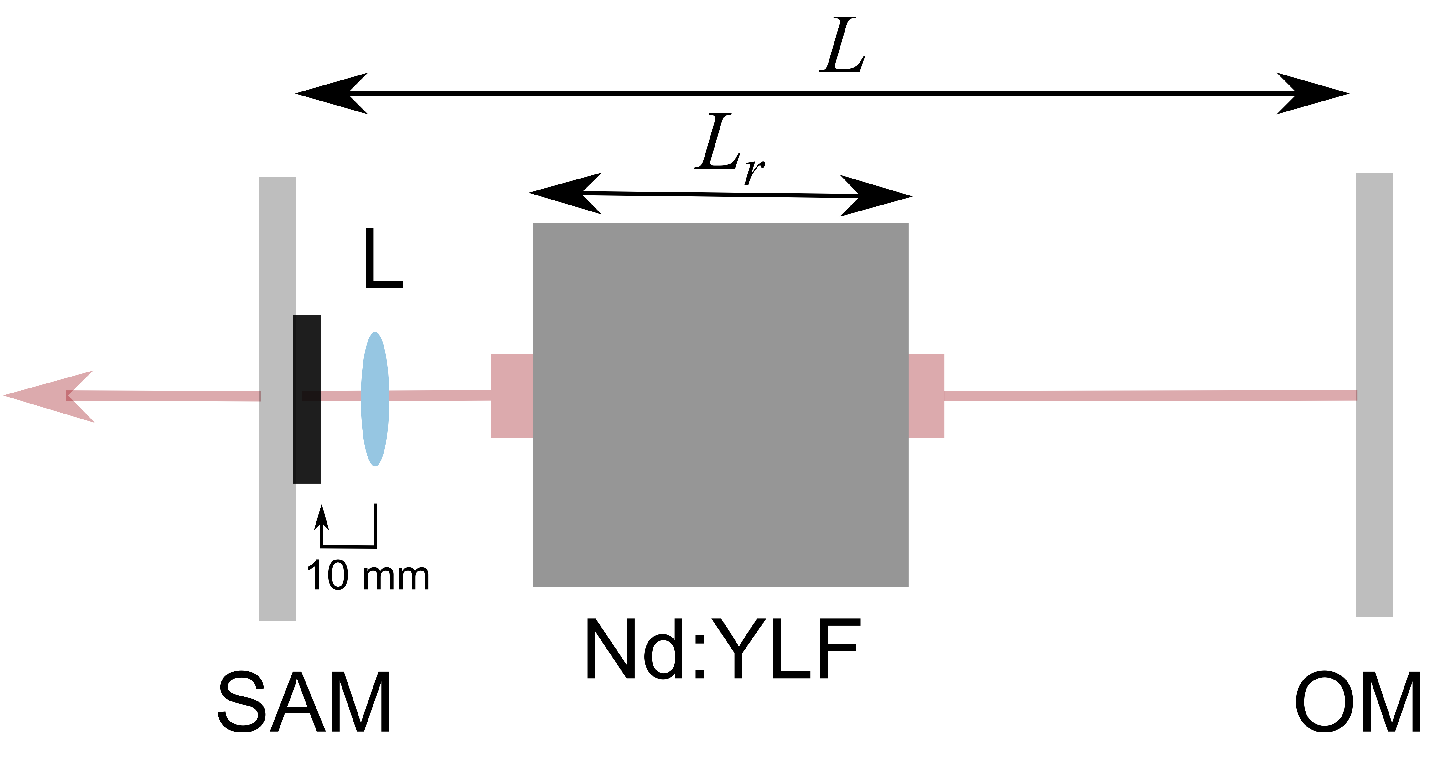
| Laser Rod | Laser Rod | Refractive Index | Cavity Length | Output Mirror | SAM Reflectivity | Beam Waist | Beam Waist |
|---|---|---|---|---|---|---|---|
| Diameter | Length | Reflectivity | at Laser Rod | at SAM | |||
| 2a = 5 mm | = 5 cm | 1.45 | L = 100 mm | = 0.98 | = 0.998 | = 800 μm | = 300 μm |
| Relaxation Times | Internal Cavity Losses | Saturation Fluences | Cavity Losses | Modulation Depth | Unsaturated Round-Trip Gain |
|---|---|---|---|---|---|
| = 480 μs | = 0.1 | = 0.046, | = 2l to 10l | ||
| = 1.45 ps | σ = 1.8 cm | 0.023, | |||
| 0.015, | |||||
| 0.010, | |||||
| 0.005. |
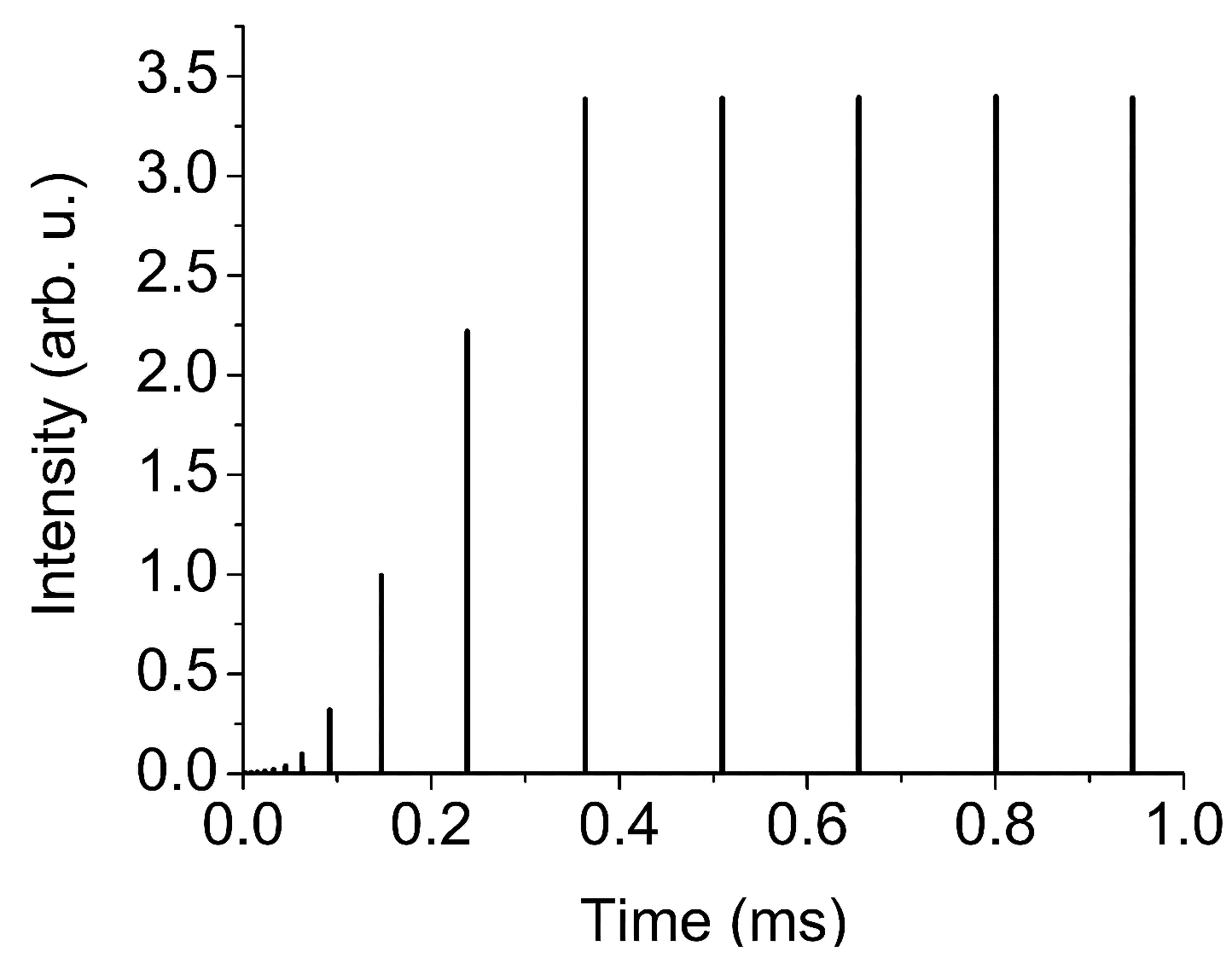
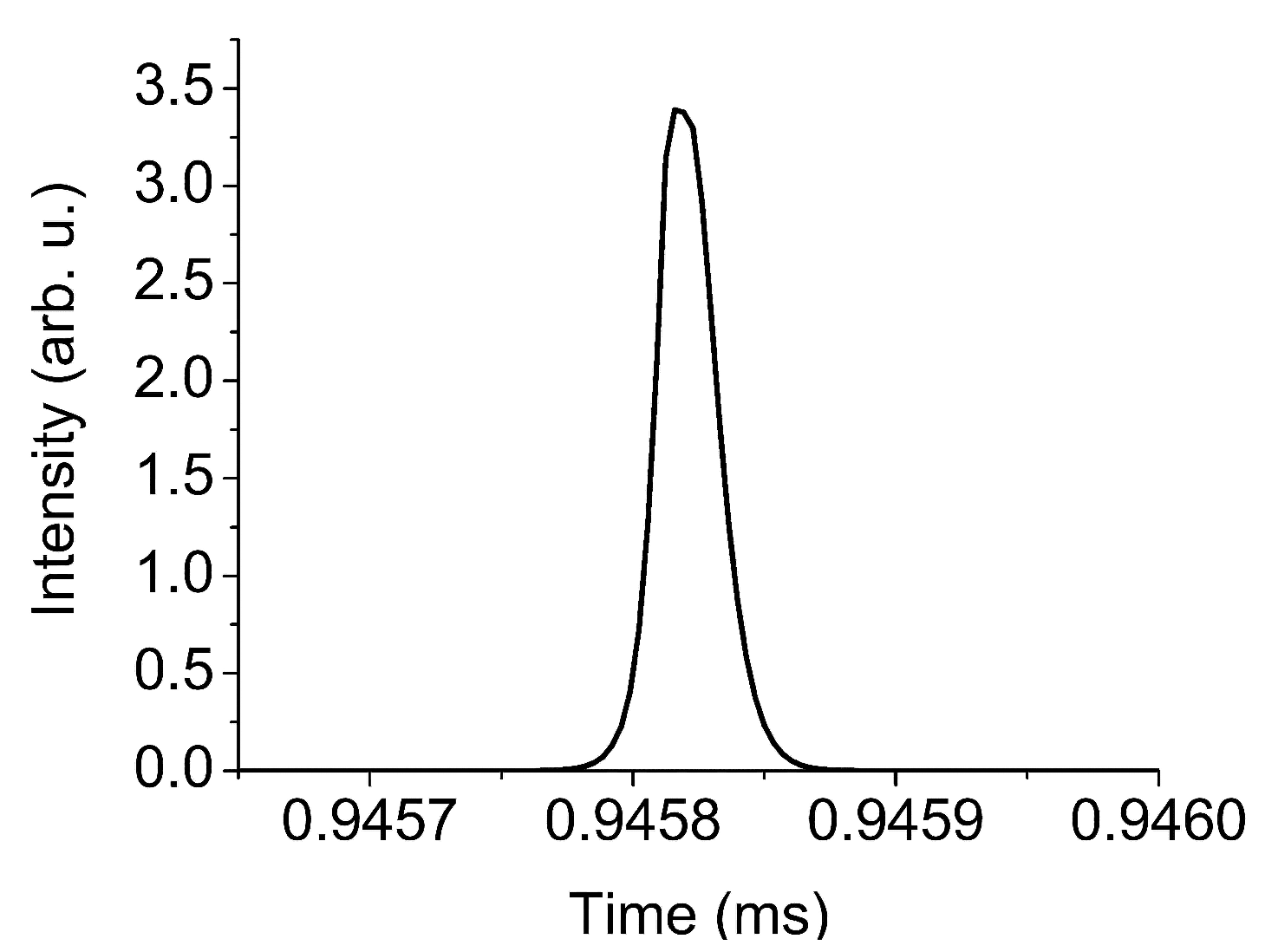
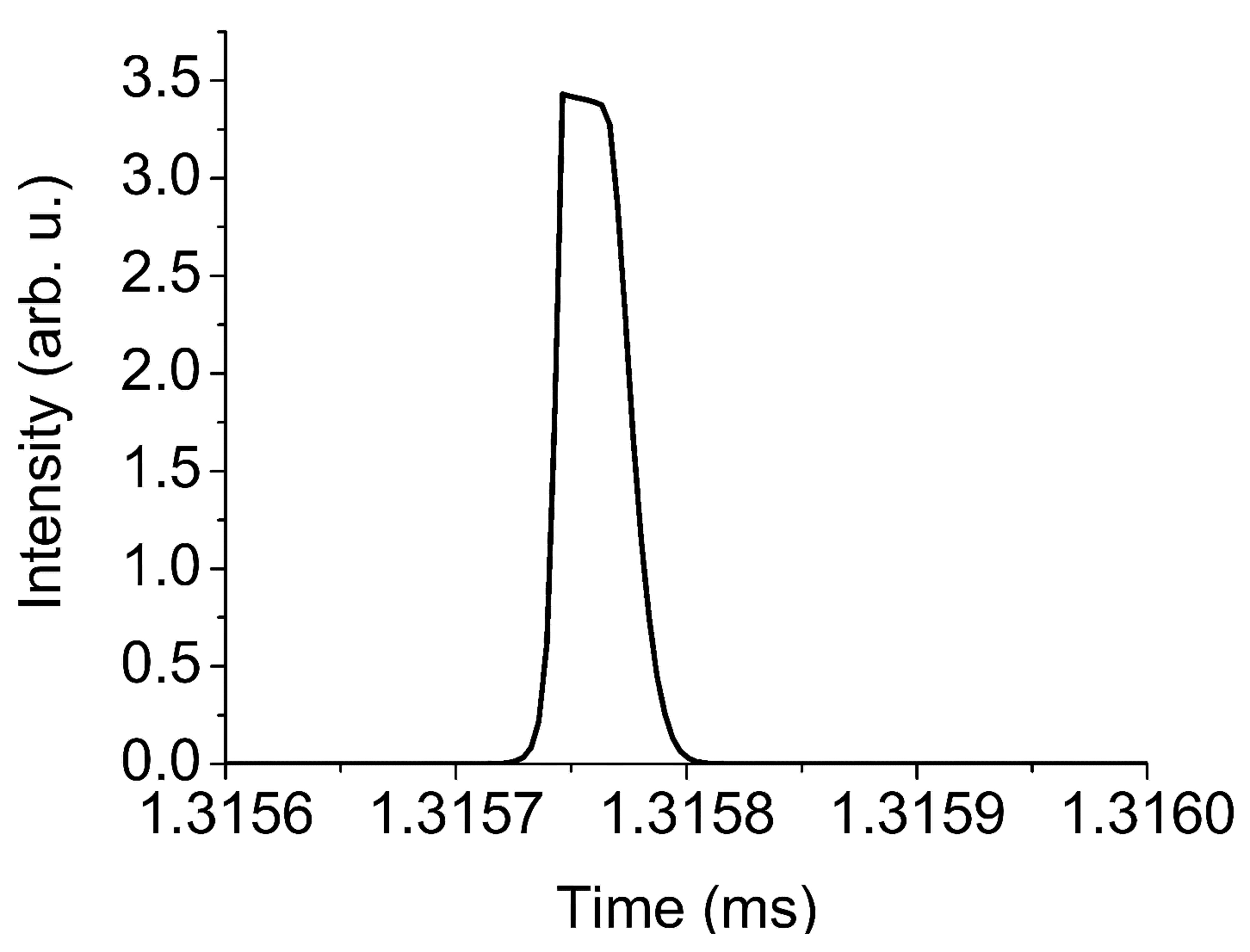
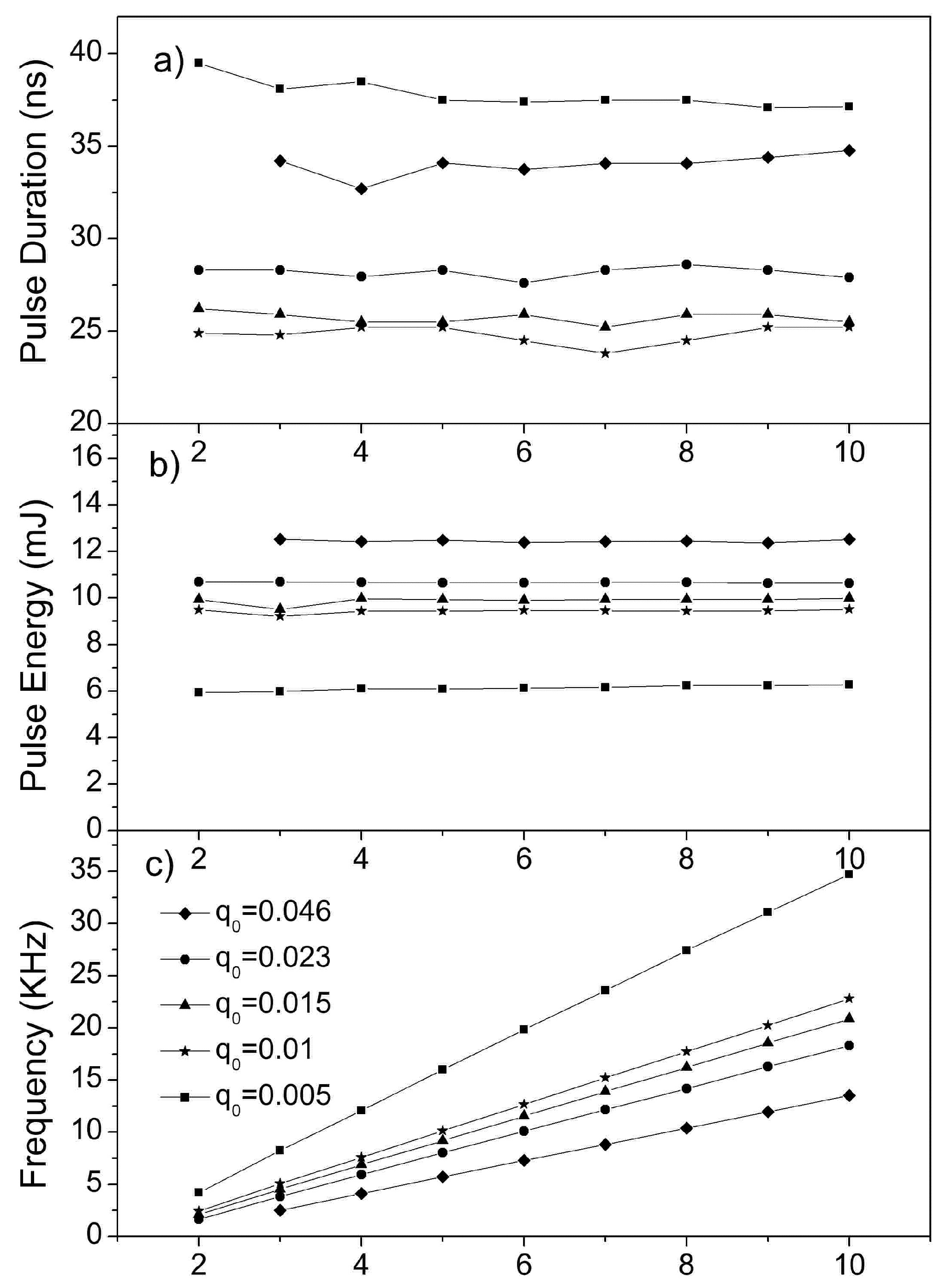
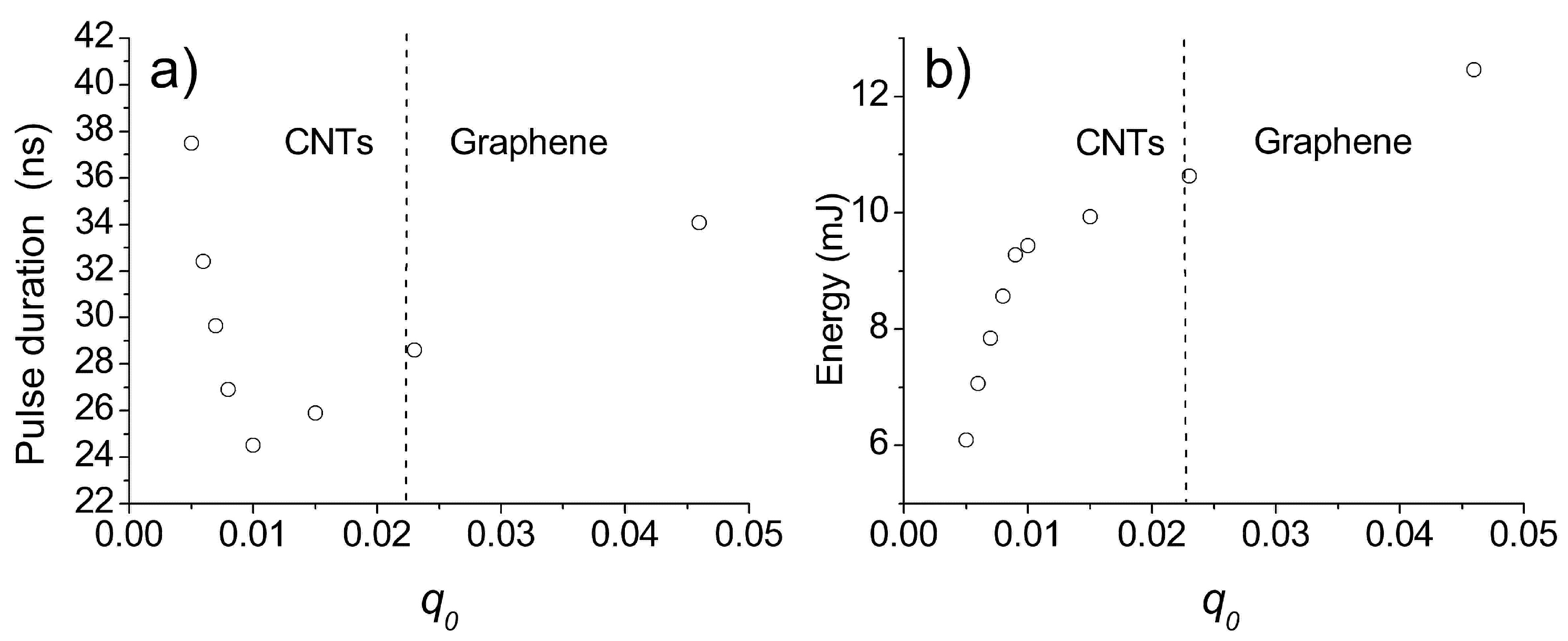
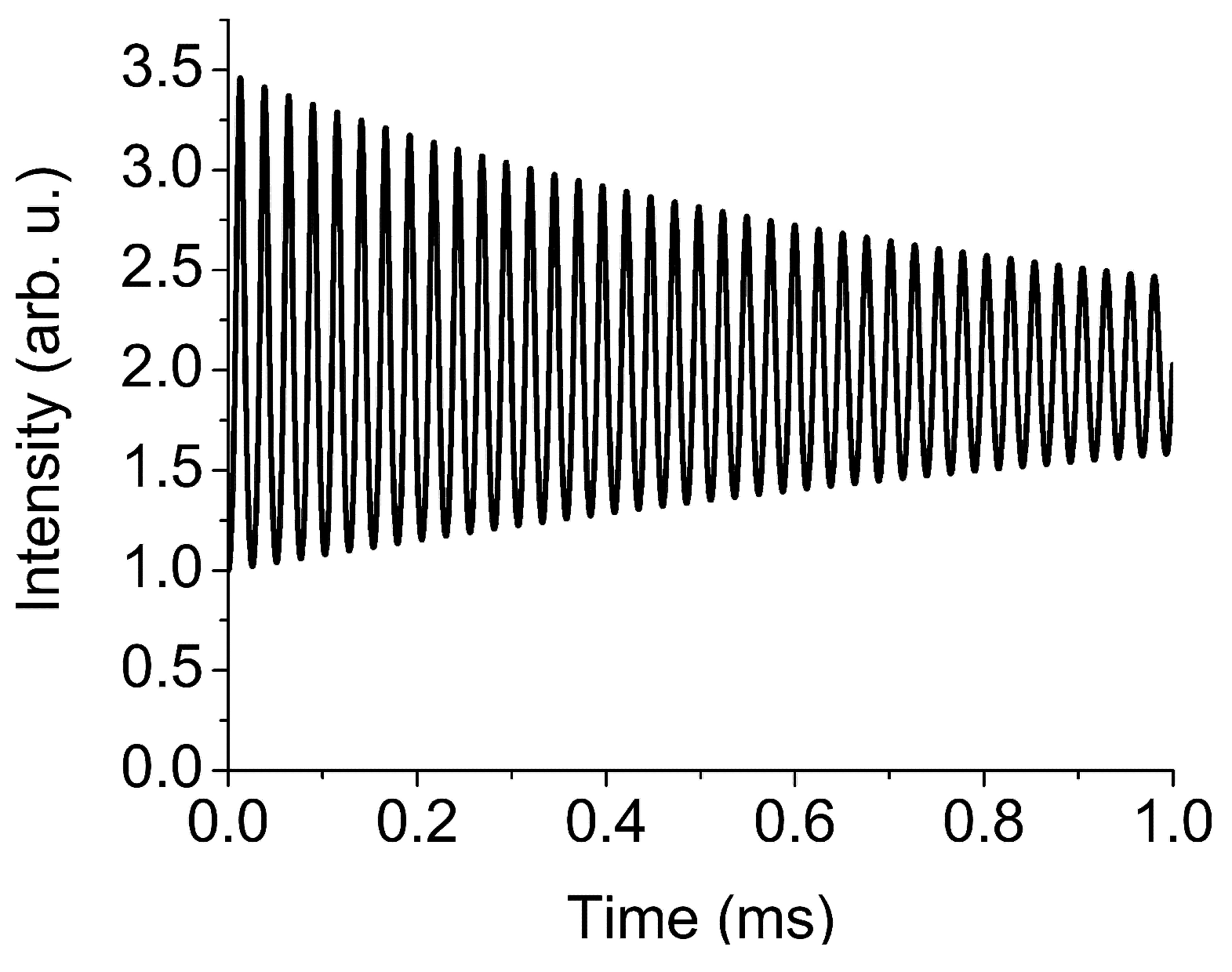
3. Conclusions
Acknowledgments
Author Contributions
Conflicts of Interest
References
- Koechner, W. Solid-State Laser Engineering; Rhodes, W.T., Ed.; Springer Series in Optical Sciences; Springer: New York, NY, USA, 2006; pp. 522–528 and 542–556. [Google Scholar]
- Cheng, K.; Zhao, S.Z.; Yang, K.J.; Li, G.Q.; Li, D.C.; Zhang, G.; Zhao, B.; Wang, Y.G. Diode-pumped passively Q-switched Nd:Lu0.33Y0.37Gd0.3VO4 laser using a single-walled carbon nanotube saturable absorber. Laser Phys. Lett. 2011, 8, 418–422. [Google Scholar]
- Set, S.Y.; Yaguchi, H.; Tanaka, Y.; Jablonski, M. Laser mode locking using a saturable absorber incorporating carbon nanotubes. J. Lightwave Technol. 2004, 22, 51–56. [Google Scholar] [CrossRef]
- Schibli, T.R.; Minoshima, K.; Kataura, H.; Itoga, E.; Minami, N.; Kazaoui, S.; Miyashita, K.; Tokumoto, M.; Sakakibara, Y. Ultrashort pulse-generation by saturable absorber mirrors based on polymer-embedded carbon nanotubes. Opt. Express 2005, 13, 8025–8031. [Google Scholar] [CrossRef] [PubMed]
- Schmidt, A.; Rivier, S.; Steinmeyer, G.; Yim, J.H.; Cho, W.B.; Lee, S.; Rotermund, F.; Pujol, M.C.; Mateos, X.; Aguiló, M.; et al. Passive mode locking of Yb:KLuW using a single-walled carbon nanotube saturable absorber. Opt. Lett. 2008, 33, 729–731. [Google Scholar] [CrossRef] [PubMed]
- Cho, W.B.; Schmidt, A.; Yim, J.H.; Choi, S.Y.; Lee, S.; Rotermund, F.; Griebner, U.; Steinmeyer, G.; Petrov, V.; Mateos, X.; et al. Passive mode locking of a Tm-doped bulk laser near 2 μm using a carbon nanotube saturable absorber. Opt. Express. 2009, 17, 11007–11011. [Google Scholar] [CrossRef] [PubMed]
- Cheng, K.; Lin, Y.; Yamashita, S.; Lin, G. Harmonic Order-Dependent Pulsewidth Shortening of a Passively Mode-Locked Fiber Laser With a Carbon Nanotube Saturable Absorber. IEEE Photonics J. 2012, 4, 1542–1552. [Google Scholar] [CrossRef]
- Cheng, K.; Lin, Y.; Lin, G. Single- and double-walled carbon nanotube based saturable absorbers for passive mode locking of an erbium-doped fiber laser. Laser Phys. 2013. [Google Scholar] [CrossRef]
- Cho, W.B.; Kim, J.W.; Lee, H.W.; Bae, S.; Hong, B.H.; Choi, S.Y.; Baek, I.H.; Kim, K.; Yeom, D.; Rotermund, F. High-quality, large-area monolayer graphene for efficient bulk laser mode locking near 1.25 μm. Opt. Lett. 2011, 36, 4089–4091. [Google Scholar] [CrossRef] [PubMed]
- Matía-Hernando, P.; Guerra, J.M.; Weigand, R. An Nd:YLF laser q-switched by a monolayer-graphene saturable-absorber mirror. Laser Phys. 2013. [Google Scholar] [CrossRef]
- Xie, G.Q.; Ma, J.; Lv, P.; Gao, W.L.; Yuan, P.; Qian, L.J.; Yu, H.H.; Zhang, H.J.; Wang, J.Y.; Tang, D.Y. Graphene saturable absorber for Q-switching and mode locking at 2 μm wavelength. Opt. Mater. Express 2012, 2, 878–883. [Google Scholar] [CrossRef]
- Li, X.L.; Xu, J.L.; Wu, Y.Z.; He, J.L.; Hao, X.P. Large energy laser pulses with high repetition rate by graphene Q-switched solid-state laser. Opt. Express 2011, 19, 9950–9955. [Google Scholar] [CrossRef] [PubMed]
- Wang, Z.T.; Zou, Y.H.; Chen, Y.; Wu, M.; Zhao, C.J.; Zhang, H.; Wen, S.C. Graphene sheet stacks for Q-switching operation of an erbium-doped fiber laser. Laser Phys. Lett. 2013. [Google Scholar] [CrossRef]
- Husaini, S.; Bedford, R.G. Graphene saturable absorber for high power semiconductor disk laser mode locking. Appl. Phys. Lett. 2014. [Google Scholar] [CrossRef]
- Huang, P.L.; Lin, S.; Yeh, C.; Kuo, H.; Huang, S.; Lin, G.; Li, L.; Su, C.; Cheng, W. Stable mode-locked fiber laser based on CVD fabricated graphene saturable absorber. Opt. Express 2012, 20, 2460–2465. [Google Scholar] [CrossRef] [PubMed]
- Lin, Y.; Yang, C.; Liou, J.; Yu, C.; Lin, G. Using graphene nano-particle embedded in photonic crystal fiber for evanescent wave mode locking of fiber laser. Opt. Express 2013, 21, 16763–16776. [Google Scholar] [CrossRef] [PubMed]
- Sali, E.; Ignesti, E.; Cavalieri, S.; Fini, L.; Tognetti, M.; Bu, R. A tuneable, single-mode titanium-doped-sapphire laser source with variable pulse duration in the nanosecond regime. Opt. Commun. 2009, 282, 3330–3334. [Google Scholar] [CrossRef]
- Sali, E.; Ignesti, E.; Cavalieri, S.; Fini, L.; Tognetti, M.; Bu, R. A titanium-doped-sapphire laser source with tunable frequency, single-mode emission, and adjustable pulse duration. Laser Phys. 2010, 20, 1126–1131. [Google Scholar] [CrossRef]
- Weigand, R.; Pinto, T.; Crespo, H.M.; Guerra, J.M. On the Q-switched operation of Titanium: Sapphire lasers using a graphene-based saturable absorber mirror. Opt. Laser Technol. 2015, 72, 1–5. [Google Scholar] [CrossRef]
- Spühler, G.J.; Paschotta, R.; Fluck, R.; Braun, B.; Moser, M.; Zhang, G.; Gini, E.; Keller, U. Experimentally confirmed design guidelines for passively Q-switched microchip lasers using semiconductor saturable absorbers. J. Opt. Soc. Am. B 1999, 33, 376–388. [Google Scholar] [CrossRef]
- Haus, H. Parameter ranges for cw passive mode locking. IEEE J. Quantum Electron. 1976, 12, 169–176. [Google Scholar] [CrossRef]
- Pollack, T.M.; Wing, W.F.; Grasso, R.J.; Chicklis, E.P.; Jenssen, H.P. Cw laser operation of Nd:YLF. IEEE J. Quantum Electron. 1982, 18, 159–163. [Google Scholar] [CrossRef]
- Frei, B.; Balmer, J.E. 1053-nm-wavelength selection in a diode-laser-pumped Nd:YLF laser. Appl. Opt. 1994, 33, 6942–6946. [Google Scholar] [CrossRef] [PubMed]
© 2015 by the authors; licensee MDPI, Basel, Switzerland. This article is an open access article distributed under the terms and conditions of the Creative Commons Attribution license (http://creativecommons.org/licenses/by/4.0/).
Share and Cite
Weigand, R.; Balmaseda, M.S.; Pérez, J.M.G. Q-Switched Operation with Carbon-Based Saturable Absorbers in a Nd:YLF Laser. Appl. Sci. 2015, 5, 566-574. https://doi.org/10.3390/app5030566
Weigand R, Balmaseda MS, Pérez JMG. Q-Switched Operation with Carbon-Based Saturable Absorbers in a Nd:YLF Laser. Applied Sciences. 2015; 5(3):566-574. https://doi.org/10.3390/app5030566
Chicago/Turabian StyleWeigand, Rosa, Margarita Sánchez Balmaseda, and José Manuel Guerra Pérez. 2015. "Q-Switched Operation with Carbon-Based Saturable Absorbers in a Nd:YLF Laser" Applied Sciences 5, no. 3: 566-574. https://doi.org/10.3390/app5030566
APA StyleWeigand, R., Balmaseda, M. S., & Pérez, J. M. G. (2015). Q-Switched Operation with Carbon-Based Saturable Absorbers in a Nd:YLF Laser. Applied Sciences, 5(3), 566-574. https://doi.org/10.3390/app5030566





